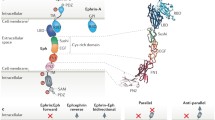Abstract
The Eph receptors are a unique family of receptor tyrosine kinases that enforce cellular position in tissues through mainly repulsive signals generated upon cell-cell contact. Together, Eph receptors and their membrane-anchored ligands, the ephrins, are key molecules for establishing tissue organization through signaling pathways that control axonal projection, cell migration, and the maintenance of cellular boundaries. Through their SH2 (Src Homology 2) and PDZ (postsynaptic density protein, disks large, zona occludens) domains, several signaling molecules have been demonstrated to interact with the activated cytoplasmic domain of Eph receptors by using the yeast two-hybrid system and in vitro biochemical assays. Most proteins found to interact with Eph receptors are well-known regulators of cytoskeletal organization and cell adhesion, and also cell proliferation. Promoting growth, however, does not appear to be a primary role of Eph receptors. Explaining which signaling interactions identified for the Eph receptors have physiological significance, how Eph receptor signaling cascades are propagated, and characterizing the intrinsic signaling properties of the ephrins are all exciting questions currently being investigated.
Similar content being viewed by others
Author information
Authors and Affiliations
Additional information
Received: 14 September 1998 / Accepted: 8 January 1999
Rights and permissions
About this article
Cite this article
Kalo, M., Pasquale, E. Signal transfer by Eph receptors. Cell Tissue Res 298, 1–9 (1999). https://doi.org/10.1007/PL00008807
Issue Date:
DOI: https://doi.org/10.1007/PL00008807




